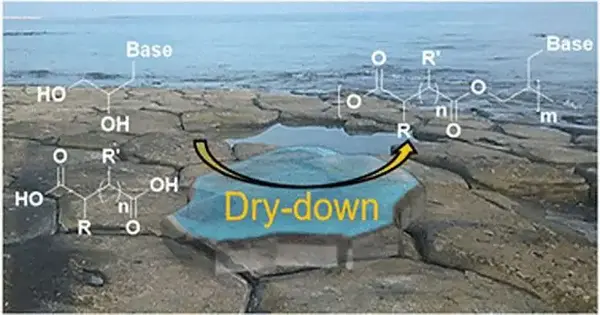For a number of decades, scientists have been trying to figure out where life began chemically on Earth. Numerous hypotheses have been put forth to explain the origin of life and the chemical and environmental factors that may have contributed to its appearance on the early Earth. The abiotic synthesis of genetic polymers—materials made up of a sequence of repeating chemical units that are capable of storing and passing down information through base-pairing interactions—is one of the steps required by a number of these hypotheses.
The RNA (ribonucleic acid) world hypothesis is one of these ideas. It says that RNA could have been the first biopolymer of life and could have been used for catalysis, storage, and transmission of genetic information. However, studies have shown that RNA polymerization would have been ineffective under primitive dry-down conditions without specialized circumstances like lipid or salt-assisted synthesis or mineral templating if RNA monomers were not chemically activated.
The fact that primitive chemical systems were quite diverse and could not have been as clean as just containing RNA and lipids suggests that other forms of primitive nucleic acid polymerization may have also taken place, although this does not necessarily make the RNA world hypothesis less plausible.
“Research indicates that putative pre-RNA molecules could be assembled from monomers with linkers that could potentially serve to connect other functional polymers to form macromolecular hybrid structures,”
Research Scientist Ruiqin Yi,
One of the major hypotheses suggests that RNA may have been preceded by a different kind of nucleic acid, known as “pre-RNA.”
As a result, co-polymerization of monomers of alternating nucleoside analogs with linker molecules is one potential and promising mechanism of prebiotic synthesis of non-RNA nucleic acids (or nucleic acid-like polymers) that could have existed on early Earth. Other mechanisms of prebiotic synthesis of non-RNA nucleic acids (or nucleic acid-like polymers) are currently unknown.
Co-polymerizations of this kind in a genetic polymer candidate that is not based on RNA and is relevant to prebiotics were the focus of an investigation carried out by a group of researchers from the Tokyo Institute of Technology, led by Research Scientist Ruiqin Yi.
Under primitive dry-down conditions, the team investigated alternating co-polymerization of glycol nucleic acid (GNA) monomers with substituted and unsubstituted dicarboxylic acids (DCA) to produce both linear and branched xeno nucleic acid co-polymers in their most recent breakthrough, which was published in Chemical Communications.
Dr. Yi provides the following explanation: “Research suggests that putative pre-RNA molecules could be assembled from monomers with linkers that potentially served to conjoin other functional polymers to form macromolecular hybrid structures.” In addition to making the polymers more complex, this increased chemical interconnectivity may have given them new or unexpected functions. This type of polymer co-synthesis has the potential to assist in tracing the beginnings of primitive genetic molecules all the way back to a time before RNA or enzymatic catalysis.”
GNA monomers N1-(2,3-dihydroxypropyl)thymine (DHPT) or N9-(2,3-dihydroxypropyl)adenine (DHPA), which contain the thymine and adenine bases that are found in modern DNA and RNA, were reacted via dehydration synthesis with a variety of substituted and unsubstituted DCAs to form ester bonds that could connect the GNA components with the
MALDI-ToF-MS (matrix-assisted laser desorption ionization time-of-flight mass spectrometry) was used to analyze the molecules of the synthesized product to determine what kinds of products might be made. Reactions with substituted DCAs produced both linear and branched co-polymers, whereas those with unsubstituted DCAs produced alternating linear co-polymers, as shown by the results. Products were always made of a polydisperse population of different lengths of polymers.
Products of varying lengths could be produced by altering the reaction pH, temperature, or composition of DCA or GNA. The DCA/GNA ratio had an effect on the amount of branching of the products when MS/MS analysis was used to “sequence” the product polymers. More branching was seen with higher DCA/GNA ratios, while more linear polymers were seen with lower ratios.
Last but not least, the team discovered that when DHPT and DHPA mixed with tartaric acid, a random sequence of polymers containing both thymine and adenine bases, which are typically able to pair with one another, formed. Similar to RNA or other primitive nucleic acids, these products suggest a possible route by which this system could generate short-chained polymers with the ability to transmit genetic information through base pairing.
This suggests that if the inventory of prebiotic organic molecules had a variety of chemical compositions, both branched and linear GNA-DCA-based xeno nucleic acid co-polymers might have been abundant on early Earth, and that simple chemical compositional differences may have caused population-level differences in the abundance of branched and linear informational polymers.
Hyperbranched polymer-based globular protoenzymes, for instance, may have been responsible for the dominance of branched polymers in environments with fewer GNA monomers than DCA molecules.
Then again, in conditions with more GNA monomers contrasted with DCA particles, a possibly exceptionally different populace of straight polymers fit for putting away and passing down hereditary data would have overwhelmed, which might have brought about additional determination and development, prompting other novel capabilities or nucleic acids.
“We discovered that not only could the simple dehydration of two types of abundant primitive molecules (GNA and DCA) yield non-canonical xeno nucleic acids, but also that these polymers with two types of complementary bases may have had useful information storage properties. Dr. Yi concludes, “We hope to uncover more answers to questions about the types of polymers that could have existed and functioned on early Earth.” We are currently in the process of diving deeper into the potential functions of these co-polymers.
More information: Ruiqin Yi et al, Alternating co-synthesis of glycol nucleic acid (GNA) monomers with dicarboxylic acids via drying, Chemical Communications (2023). DOI: 10.1039/D2CC06818D





